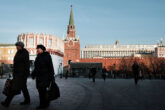May 16, 2022
Potential US responses to the Russian use of non-strategic nuclear weapons in Ukraine
When the rhetoric from the Russian political and military leadership turns to the possibility of a war pitting the United States and its NATO allies against Russia, the mention of nuclear weapons is usually close behind. Russian Foreign Minister Sergei Lavrov recently raised the nuclear specter over the Ukraine war, insisting that NATO is engaging in a proxy war with Russia. While insisting that Russia seeks to avoid nuclear war at all costs, he warned that the “danger is serious, real, and we must not underestimate it.”
This is double talk typical of Lavrov; through it, he attempts to paint Russia as a responsible actor, even though Russia is the only actor in this war that would consider using nuclear weapons. The Russian leadership has also used nuclear threats to signal its displeasure with the expansion of NATO, suggesting it will deploy nuclear-capable missiles near Finland and Sweden if they join the alliance.
Russian use of a nuclear weapon or weapons in Ukraine would greatly increase the likelihood of direct NATO-Russia conflict.
Many of these nuclear threats are signals, meant to politically coerce. But what if Russian President Vladimir Putin decided to use a nuclear weapon in Ukraine to change the apparent negative direction of the Russian invasion there? Four response options seem at least plausible: the West could use a nuclear weapon or weapons against Russian forces, in or outside Ukraine; it could conduct a conventional military attack on Russian forces, in or outside Ukraine; it could continue its current policy of supplying Ukraine with weapons while avoiding direct conflict with the Russian military; or it could press Ukraine to settle the conflict, on terms that give Russia a face-saving out.
Responding in-kind to a Russian nuclear attack and caving to nuclear coercion are clearly unwise, but the other options have risks and uncertainties that make one thing obvious: Russian use of a nuclear weapon or weapons in Ukraine would greatly increase the likelihood of direct NATO-Russia conflict.
Read the full article from The Bulletin of Atomic Sciences.
More from CNAS
-
Can the Global Order Be Saved? Not Without Punishing Russia
The only way to succeed in the urgent task of achieving a just peace settlement, therefore, is radically reshaping Russia’s calculus....
By Nicholas Lokker
-
CNAS Insights | Russia Is Winning the Battle for Influence in Nigeria
Across Africa, Russia and its proxies are well known for providing security and extracting wealth. In the Sahel the Wagner Group, and subsequently the Russian Defense Ministry...
By Kate Johnston
-
Transatlantic Tensions in the New National Security Strategy
On December 4th, the Trump administration released its long-awaited national security strategy, sending another round of shock waves through the transatlantic community. The N...
By Andrea Kendall-Taylor & Jim Townsend
-
Transatlantic Security / Middle East Security
The Russia-Iran Partnership: A Geopolitical Balancing ActIt has been almost a year since Russia and Iran signed their comprehensive strategic partnership. That deal established a 20-year partnership between the two countries coverin...
By Andrea Kendall-Taylor & Jim Townsend




